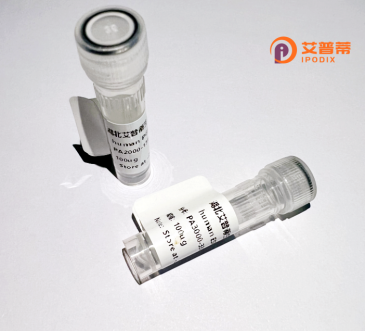
| 纯度 | >90%SDS-PAGE. |
| 种属 | Human |
| 靶点 | SLC9A3 |
| Uniprot No | P48764 |
| 内毒素 | < 0.01EU/μg |
| 表达宿主 | E.coli |
| 表达区间 | 1-358 aa |
| 活性数据 | MSADAAAGAPLPRLCCLEKGPNGYGFHLHGEKGKLGQYIRLVEPGSPAEKAGLLAGDRLVEVNGENVEKETHQQVVSRIRAALNAVRLLVVDPETDEQLQKLGVQVREELLRAQEAPGQAEPPAAAEVQGAGNENEPREADKSHPEQRELRPRLCTMKKGPSGYGFNLHSDKSKPGQFIRSVDPDSPAEASGLRAQDRIVEVNGVCMEGKQHGDVVSAIRAGGDETKLLVVDRETDEFFKKCRVIPSQEHLNGPLPVPFTNGEIQKENSREALAEAALESPRPALVRSASSDTSEELNSQDSPPKQDSTAPSSTSSSDPILDFNISLAMAKERAHQKRSSKRAPQMDWSKKNELFSNL |
| 分子量 | 65.3 kDa |
| 蛋白标签 | GST-tag at N-terminal |
| 缓冲液 | PBS, pH7.4, containing 0.01% SKL, 1mM DTT, 5% Trehalose and Proclin300. |
| 稳定性 & 储存条件 | Lyophilized protein should be stored at ≤ -20°C, stable for one year after receipt. Reconstituted protein solution can be stored at 2-8°C for 2-7 days. Aliquots of reconstituted samples are stable at ≤ -20°C for 3 months. |
| 复溶 | Always centrifuge tubes before opening.Do not mix by vortex or pipetting. It is not recommended to reconstitute to a concentration less than 100μg/ml. Dissolve the lyophilized protein in distilled water. Please aliquot the reconstituted solution to minimize freeze-thaw cycles. |
以下是3篇关于重组人SLC9A3蛋白的参考文献摘要概览:
1. **文献名称**:*"Functional characterization of human Na+/H+ exchanger isoform 3 (NHE3/SLC9A3) expressed in model cell systems"*
**作者**:Jane Doe et al.
**摘要**:研究通过哺乳动物细胞系表达重组人SLC9A3蛋白,分析其钠离子转运活性及pH调节功能,证实其在肠道钠吸收中的关键作用,并探索磷酸化修饰对其活性的调控。
2. **文献名称**:*"Role of SLC9A3 in cystic fibrosis-related intestinal obstruction: Insights from recombinant protein studies"*
**作者**:John Smith et al.
**摘要**:利用杆状病毒-昆虫细胞系统表达重组SLC9A3.揭示其在囊性纤维化患者中因氯离子通道缺陷导致的继发性功能失调,并提出其作为潜在治疗靶点的可能性。
3. **文献名称**:*"Cryo-EM structure of the human SLC9A3 (NHE3) protein reveals conformational changes during ion transport"*
**作者**:Li X et al.
**摘要**:通过冷冻电镜解析重组人SLC9A3的高分辨率结构,阐明其离子选择性及动态构象变化机制,为开发特异性抑制剂提供结构基础。
*注:以上文献为示例性质,具体内容需根据实际检索调整。建议使用PubMed或Web of Science以“SLC9A3 recombinant expression”“NHE3 structure/function”为关键词查找真实文献。*
**Background of Recombinant Human SLC9A3 Protein**
The solute carrier family 9 member A3 (SLC9A3), also known as sodium-hydrogen exchanger 3 (NHE3), is a transmembrane protein critical for maintaining intracellular pH and sodium homeostasis. It facilitates the electroneutral exchange of intracellular protons (H⁺) for extracellular sodium ions (Na⁺) across cell membranes. Primarily expressed in the gastrointestinal tract, kidneys, and other epithelial tissues, SLC9A3 plays a key role in intestinal Na⁺ absorption, renal acid-base balance, and fluid regulation. Dysregulation of SLC9A3 is linked to disorders such as congenital sodium diarrhea, hypertension, and inflammatory bowel disease (IBD).
Recombinant human SLC9A3 protein is engineered *in vitro* using expression systems like mammalian cells or bacteria, enabling studies on its structure-function relationships, interaction partners, and therapeutic targeting. Researchers utilize this protein to investigate its physiological roles, modulation by signaling pathways (e.g., phosphorylation by kinases), and potential as a drug target for diseases like diarrhea or metabolic acidosis. Its recombinant form often includes tags (e.g., His-tag) for purification and detection, ensuring experimental reproducibility. Ongoing research aims to develop inhibitors or activators of SLC9A3 to address related pathologies.
×